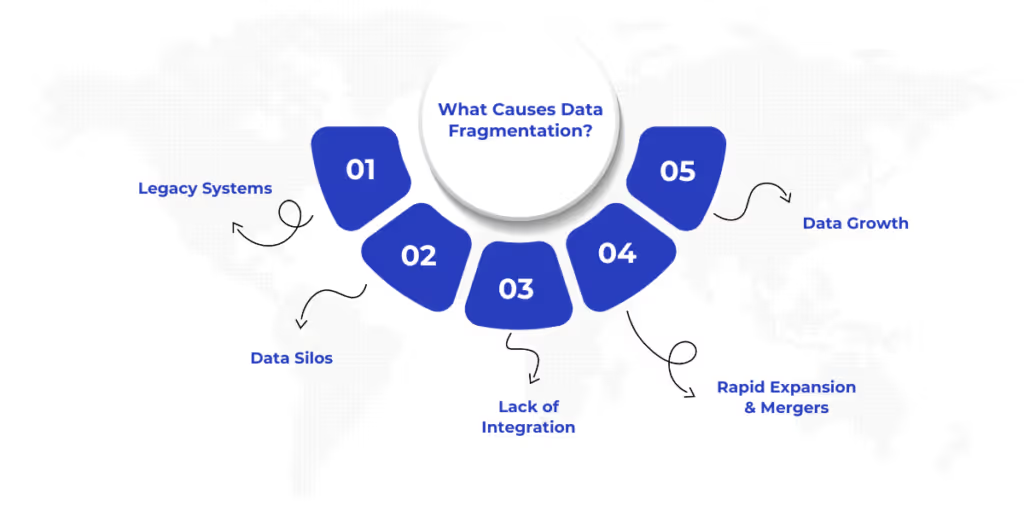

Data fragmentation is one of the most significant challenges businesses face today, especially when it comes to making informed decisions. Renowned statistician and data visualization expert Edward Tufte emphasizes the importance of minimizing fragmentation in data presentation. He argues that the cognitive load increases when data is split across multiple pages or datasets, effectively reducing our ability to interpret and analyze information (Tufte, 2001). This fragmentation, where data is siloed across various systems and platforms, makes it difficult to establish connections, identify trends, and draw actionable insights.
In this article, we’ll explore effective strategies and solutions for overcoming fragmented data systems.
Data fragmentation occurs when business data is spread across multiple storage systems, databases, or platforms, making it difficult to access and manage efficiently. This fragmentation prevents organizations from obtaining a unified, real-time view of their information.
There are two primary types of data fragmentation: physical fragmentation, where data is stored across various servers or devices, and logical fragmentation, where different versions of the same data exist on separate systems. Both types contribute to data inconsistency, delayed retrieval times, and a lack of integration across departments.
With a clearer understanding of data fragmentation, it’s important to examine the key causes contributing to fragmented data systems.

Understanding the root causes of fragmented data systems is key to tackling the issue effectively. Several factors contribute to data fragmentation, and addressing these causes can pave the way for a more efficient, streamlined data strategy.
Many organizations still operate on legacy systems, which are outdated software and hardware that weren't designed to handle the vast amounts of data businesses generate today. These older systems typically use obsolete architectures that struggle to meet modern data storage and processing demands, resulting in fragmented data.
Moreover, legacy systems often lack the scalability required to accommodate a growing business. As companies expand, their data needs increase, but legacy systems usually cannot handle the surge in volume. This inability to scale leads to disjointed infrastructure, forcing businesses to put in extra effort to manually consolidate or clean fragmented data manually, further complicating their data management processes.
Data silos arise when different departments or business units store and manage their data in isolation. These silos emerge when systems, such as enterprise resource planning (ERP) software, customer service platforms, or inventory management tools, are not designed to share data across the organization. As a result, sales, marketing, finance, and customer service may each use different systems, creating a fragmented view of the company’s performance.
As businesses grow, they often adopt new technologies and tools to handle specific functions. Over time, these systems may not integrate well with each other, causing fragmentation. A lack of proper integration tools can make data access and analysis more difficult, as data remains isolated in different systems.
When a company expands rapidly or acquires new businesses, the integration of different data systems becomes a significant challenge. Each newly acquired entity may have its own systems, tools, and data storage methods, leading to a patchwork of disparate systems. These inherited systems might be outdated, incompatible, or simply not aligned with the parent company’s data infrastructure.
The sheer volume of data businesses generate and collect daily can cause fragmentation. As data grows, it becomes more challenging to organize and manage efficiently, especially if the systems in place aren’t scalable. Without proper data management tools, this growth can lead to fragmentation over time.
Once we understand what causes data fragmentation, we can recognize its significant impacts on business operations and decision-making.
When data is scattered across multiple systems, it disrupts the smooth functioning of an organization. The impacts of fragmented data systems are far-reaching, affecting everything from decision-making to compliance. Here are the key impacts:
Fragmented data systems make it difficult to ensure consistency and accuracy across datasets. When data is stored in multiple locations, it’s harder to maintain a single, reliable version. This inconsistency can lead to incomplete or incorrect insights, directly impacting decision-making. If departments or systems work off different versions of the same data, the conclusions drawn may be flawed or outdated, limiting the ability to generate actionable insights for business strategy.
Organizations must protect sensitive data and comply with data protection regulations. Fragmented data systems complicate compliance efforts by making it difficult to track where data is stored, who has access to it, and how it is used. This lack of visibility increases the risk of data breaches and non-compliance with laws such as GDPR or HIPAA. If data isn’t centralized and managed properly, companies face legal penalties, fines, and reputational damage due to their inability to guarantee the security and proper handling of sensitive information.
Handling fragmented data is resource-intensive. Employees must spend significant time tracking information from multiple systems, often manually reconciling discrepancies. This not only diverts resources away from core business activities but also leads to inefficiencies in data management. As a result, businesses waste time and money trying to ensure that data is accurate and up-to-date across different platforms, which could otherwise be spent on more strategic and productive initiatives.
The challenges of fragmented data systems are clear. However, there are strategies to tackle these issues and streamline data management across the organization. Let’s explore the most effective solutions.
Data fragmentation often results from a combination of outdated systems, misaligned processes, and rapid organizational growth. However, it is possible to combat fragmentation with the right strategies. Here, we outline practical, effective steps to address fragmented data systems while ensuring scalability, flexibility, and consistency across your data architecture.
One of the best ways to address fragmented data systems is to consolidate information into centralized data repositories. Moving from isolated data storage to data lakes or data warehouses allows businesses to unify their data in a structured, accessible way. Data lakes handle raw, unstructured data, while data warehouses manage structured data that can be quickly analyzed. These solutions create a unified view of the organization’s data, making extracting insights easier and reducing the complexity of managing data across multiple platforms.
Data governance is essential for maintaining high-quality, accessible data. By setting clear data usage, security, and privacy standards, businesses can create a framework that helps prevent fragmentation. It is crucial to establish who owns the data, who can access it, and what quality standards must be followed. Enforcing data governance policies ensures that data stays organized, secure, and consistent across departments, minimizing the risk of siloed data and fragmentation.
A scalable data strategy is key to managing growing data needs. Businesses should design their data infrastructure to accommodate current and future data demands. This means aligning data architecture with long-term business goals and ensuring it can handle increased data volume and more diverse data sources over time. By anticipating future growth and technological advancements, organizations can build a flexible framework that evolves without causing data fragmentation.
Continuous data monitoring and quality checks are essential for ensuring the integrity of your data. Businesses can quickly detect and resolve discrepancies by implementing automated tools to monitor data as it is collected and processed. Real-time data monitoring tools can also identify anomalies and clean data before they cause fragmentation. Ensuring data accuracy and consistency through automated systems helps maintain data reliability and reduces the chances of encountering fragmented data systems.
Migrating to cloud platforms allows businesses to scale their data management solutions. Cloud solutions are built to support large amounts of data with flexibility and security, making it easier to integrate various data sources. By centralizing data storage in the cloud, businesses can improve access, enhance security, and enable smoother data integration. The cloud also supports using advanced tools like machine learning and artificial intelligence to manage data fragmentation and improve overall data governance.
One of the primary contributors to data fragmentation is the lack of communication between departments. Each department often uses its own tools and systems, resulting in isolated data. Organizations should foster collaboration between IT teams, business units, and data owners to avoid this. By establishing standardized data formats, naming conventions, and shared protocols, businesses can ensure consistency and eliminate data silos, ultimately minimizing fragmentation.
Data integration becomes much easier when automation is employed. Using automated tools to sync data across different systems, departments, and platforms ensures that information is constantly updated and aligned. For instance, when integrating new data from acquisitions or different business units, automation can simplify the process by automatically reconciling differences and ensuring that all data is formatted and accessible. This reduces the time spent manually consolidating data and minimizes the risk of errors contributing to fragmentation.
With the increasing complexity of data systems, security, and privacy concerns must be at the forefront of any data integration strategy. New data sources and integration platforms must be secure, compliant with regulations, and designed to protect sensitive information. Implementing encryption, secure access controls, and regular audits ensures that data remains safe from breaches or unauthorized access. Ensuring strong data security practices helps protect your data's integrity while ensuring compliance with industry regulations.
Now that we've explored effective strategies for solving data fragmentation, let's look at the benefits organizations can reap by addressing this critical issue.
Addressing fragmented data systems brings immediate and long-term rewards that can dramatically enhance an organization's performance. Though it may take initial effort, fixing fragmentation can lead to smooth, efficient operations, data-driven decisions, and cost savings. Here’s how resolving fragmentation can help your business:
When fragmented data systems are consolidated, redundancy and inconsistencies decrease. This leads to cleaner data, which is significantly enhanced in accuracy and quality. With reduced duplication, businesses can confidently rely on their data for decision-making, minimizing errors in reporting and analysis.
Data fragmentation makes it difficult to gain a comprehensive view of your business. Once fragmented data systems are resolved, decision-makers have access to more complete and reliable data, which results in better strategic decisions. Unified data provides a holistic view of the organization's operations, allowing leaders to make smarter, quicker choices.
Fragmented data systems require extra time and resources for manual consolidation and troubleshooting. By addressing fragmentation, companies can automate processes and integrate data seamlessly. This not only saves valuable time but also reduces the risk of mistakes, making the organization more efficient overall.
When businesses struggle with fragmented data, they often use more resources to maintain, clean, and consolidate information. Once fragmentation is addressed, resource allocation becomes more efficient. This leads to significant cost savings, whether through reducing redundant software, optimizing storage, or streamlining workflows.
Data fragmentation can complicate regulatory compliance. By resolving fragmentation, businesses can ensure that their data is stored securely, follows compliance regulations, and is easy to audit. Centralized data systems make it easier to implement privacy controls and track access to sensitive information, minimizing the risk of security breaches or non-compliance.
When data is fragmented, collaboration suffers. Different departments may rely on separate systems that don’t communicate well. By resolving fragmentation, teams can access the same datasets, making collaboration smoother and more productive. This leads to more coordinated efforts and better alignment across the organization.
Fragmented data systems pose a significant challenge to organizations of all sizes, from mid-market companies to large enterprises. Yet, resolving this issue isn’t just a technical necessity; it’s a critical factor for organizational success. Businesses can unlock improved data quality, stronger decision-making capabilities, and more efficient operations by addressing data fragmentation.
Addressing fragmented data systems through centralized storage, strong data governance, and cloud solutions improves accessibility, compliance, and business performance. These strategies streamline processes, enhance collaboration, reduce costs, and boost operational effectiveness.
At WaferWire, we recognize the importance of clean, integrated data. Our end-to-end services are tailored to assist businesses in navigating the intricate digital transformation process. Whether you aim to consolidate data, enhance governance, or maintain security, we are here to confidently support you in making those vital data decisions.
Contact us today to start your journey toward better data management. Together, we can transform your data into a powerful asset that drives success.
APA Citation: Tufte, E. R. (2001). The visual display of quantitative information (2nd ed.). Graphics Press.

